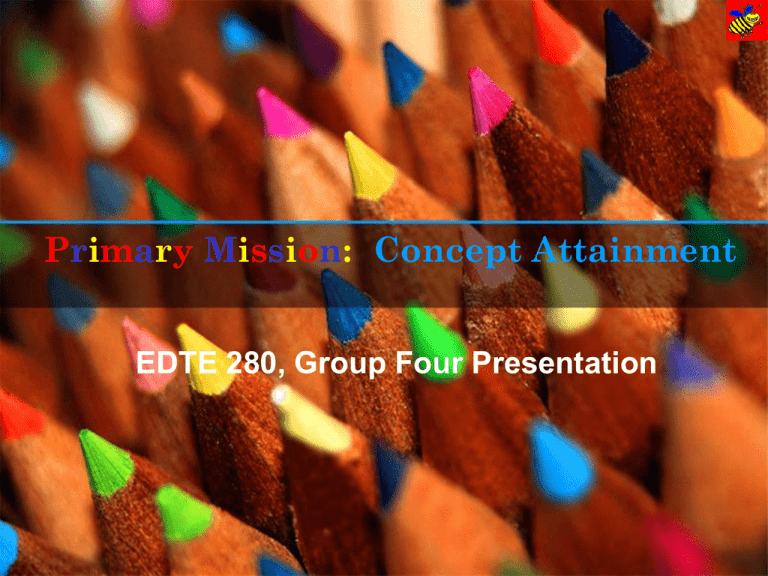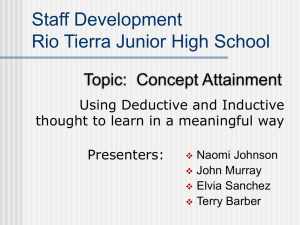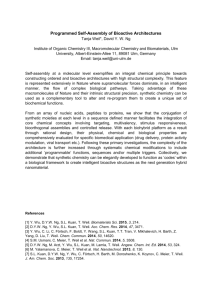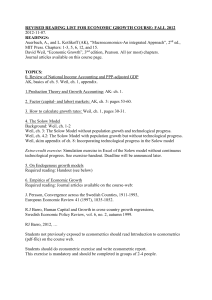Concept Attainment
advertisement

Primary Mission: Concept Attainment EDTE 280, Group Four Presentation Group Members Derek Oliver Summary & References Carl Thelen Introduction Susan Bruno Lesson Randall Ulrich Summary & References Mela Bennett Handouts Introduction Our lesson is about colors. The location is a classroom, though this lesson can really be used anywhere. The level is first grade, so the audience is six-year-olds. As kids grow up, they learn their colors. However, for them colors are just colors -- they don't have any different categories. Yet. Our lesson introduces them to the most basic category of colors, the Primary Colors. You remember those, right? Red, yellow, blue. Not the new-fangled RGB used in computer graphics, or Cyan, Magenta, Yellow, Black used in printing. Just red, yellow, and blue, like our shirts. Introduction Per Pritchard's plan including concept, rule, and critical attributes: Our concept is Primary Colors. The rule is: Primary colors are Red, Yellow, and Blue. The critical attributes are: A) It's a color. B) It's red, yellow or blue C) The object doesn't matter; only the color matters. Introduction We will try to use both the concept attainment model and multiple intelligences in our lesson, using visuals and physical toys. And shirts. So Susan will begin with background information and the lesson. . . . The Wonderful World of Color! Image Placeholder Scaffold Concepts Attention Class! Now that you are all six years old again, please give Mela your attention. She has a fun activity for you! Does it fit? Does it fit? Does it fit? These are Primary Colors! Red, Blue & Yellow Boulware & Crow Article • The Concept Attainment Strategy is an instructional technique proposed by Jerome Bruner (Bruner, 1966; Joyce, Weil, & Calhoun, 2004) that targets the “big idea” or concept. • The strategy focuses on the meaning or understanding of a concept rather than on what the concept is called. • Learners are given specific steps to scaffold their thinking, which include viewing examples as well as nonexamples of a concept. • Phase 1: The Concept to Be Taught. • Phase 2: Testing Attainment of the Concept. • Phase 3: Analysis. Joyce, Weil, & Calhoun Book • Concept Attainment versus Concept Formation oConcept Attainment: "search for and listing of attributes that can be used to distinguish exemplars from nonexamplars" (quoting Bruner, Goodnow, and Austin (1967)). (p. 108.) oConcept Formation: basis of the inductive reasoning model. (p. 108.) • Exemplars: a subset of a collection of data. (p. 111) • Attributes: data that has features. (p. 111) Joyce, Weil, & Calhoun Book Joyce, Weil, & Calhoun, quoting (Tennyson and Cocchiarella (1986): "...the first positive exemplars presented should be the clearest possible prototypes..." (p.116) References Pritchard, Johnson, Joyce, B., Williams, J.,F. P., Weil, Carlson, F.& Carnine, M., & S.,Teaching Calhoun, Kastl, D.L.(1981). J., thinking E. & (2009). Kastl, Relationship across R. Models (1992, the between of curriculum Boulware, B., &(1994). Crow, M. March). Using the concept References available in(2008, accompanying handout November/December). with teaching range the ofconcept examples (8th ed.). attainment and Boston, Developing of instructions model. MA: Pearson conceptual Descriptive and Education. attention report. in attainment strategy to enhance reading comprehension. thinking: Retrieved concept Teacher, attainment. The February concept 2,Journal attainment 2009, from of Educational model. ERIC database. Clearing Research, Reading 61(6), 491-495. Retrieved January 20, House, 74(3).from Retrieved 66(2), 117-121. January Retrieved 19, 2009,January from Academic 20, 2009, 2009, ERIC database. from Search ERIC Premier database. database. Thank you…any questions?








